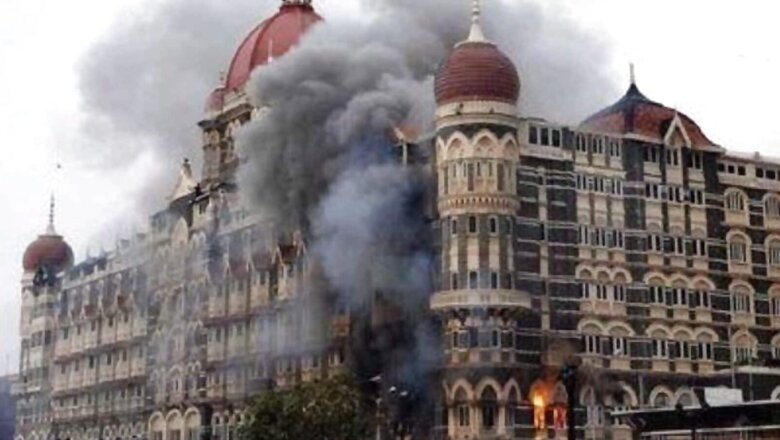
views
Why did India not go to war with Pakistan? Why, despite repeated provocations by Pakistan, did India restrain itself from an immediate and visible retaliation post 26/11? After all, that would have been the natural course of action to undertake under the given circumstances? This question has intrigued analysts. Many more have tried to discern and present reasons for the policy of restraint followed by Delhi after an assault that has become the scarred and perennial watershed in the Indo-Pak paradigm.
It was not that war was never an option. The armed forces had cranked up their readiness and surveillance levels all along the border, post the attack. There were several close calls and the IAF operational readiness platforms were also activated. One of these was the consequence of a hoax call made to the president of Pakistan posing himself to be India’s external affairs minister. Only when the US Secretary of State Condoleezza Rice intervened did it become evident that the call was a con, a deliberate provocation, to add fuel to the fire. It is also strange that the Pakistani president’s office put the call through without even verifying the credentials of the caller. The caller’s identity was never ascertained. Though a year later, it was reported in some newspapers that the caller ostensibly was the British-born terrorist Omar Sheikh, then serving a life term in a high-security Karachi Jail for the murder of the Wall Street Journal correspondent, Daniel Pearl. The Pakistani deep state however buried the investigation after the initial reports in November 2009.
Were the same actors who had perpetrated 26/11 now provoking both India and Pakistan to go to war? Was that the real objective of the Mumbai attack? In the absence of any sustained investigation by Pakistan and with every possible attempt by its intelligence agencies to bury this particular side show that may have actually unravelled a can of worms, the truth would never really come out.
There is, however, a school of thought that has been arguing from that time onwards that ‘more was to be gained from not attacking Pakistan than from attacking it.’ What were these argued gains? Well for one, it states that if India would have indeed attacked Pakistan, it would have just become another India-Pakistan dispute. Any conventional attack would have meant taking the issue to the international corridors of justice. Considering all the previous Indo-Pak disputes, the world would have responded with the default, i.e., to call for peace and split the blame and credit equally between both the states in the name of fairness, yet again equating the victim with the aggressor. Additionally, such an attack would have united Pakistan behind the Pakistani Army and weakened the civilian government in Pakistan.
This school of thought further argues that Dr Manmohan Singh’s approach appears to have been grounded in military realism. If India were to launch small, carefully chosen strikes, it would only further lessen Pakistan’s apprehensions of a rigorous conventional attack in the future. Additionally, a limited strike would have not resulted in any substantial gain. If India were to attack the LeT HQ at Muridke, it would have hardly affected the terrorist organization. ‘The LeT camps are tin sheds and huts which can be rebuilt easily.’ Moreover, these camps are deliberately set up near hospitals and schools so that any strike on these camps could result in heavy civilian casualties thereby handing over a propaganda tool to the Pakistanis.
Finally, a war, even one that India could have won, would have come at a heavy cost at a time when the world was in the throes of an unprecedented financial crisis, the economic meltdown of 2008 triggered by the sub-prime crisis. It would have set back the exceptional progress the Indian economy had made by at least a decade, if not more.
While in retrospect, it is always easier to find rational justifications for choices made, the problem is that this kind of restraint only produces results if both the parties to a negotiation are on the same page and have similar goals. Both parties should be stepping away from the ticking time bombs of history. However, if the other side (Pakistan in this case) continues to have mala fide intent and wants to run with the hare and hunt with the hounds, it becomes a self-defeating strategy for the side with kosher intent (India in this case).
It is evident that post 26/11, the Indian objectives had taken a drastic turn towards non-coercive diplomacy. Such an approach therefore lacks even the aspect of deterrence and is more difficult to execute. Moreover, it becomes difficult if not impossible to assuage inflamed public emotions that then rightly believe that no cost is being imposed on the belligerents for their murderous depredations. Such an approach naturally then lent itself to the ‘soft on terror’ cliché that stuck to the then UPA government like a noxious epithet for the remaining part of its first and second term. It is these reasons and, above all, the imperatives of political messaging for the current dispensation that since the September 2016 Uri attack, the policy of strategic restraint has given way to more tactical and forward leaning responses.
For the sake of argument, let us consider the outcomes of limited strike/Cold Start retaliation. Cold Start, as mentioned earlier, developed after it had taken the army more than a month to fully mobilize along the Pakistani border during Operation Parakram. However, even five years after Parakram, it was evident that the doctrine was not ready for operationalization and therefore virtually redundant in dealing with contingencies of this order. The land-based option thus was a non-starter from the word go.
However, air strikes against the LeT and JuD military camps in POK with a simultaneous presentation of dossiers indicating clear involvement of the Pakistani state (tapes of phone calls made by the terrorists from the high seas to their commanders in Pakistan, the micromanagement of the entire operation by Pakistan-based handlers and even Kasab’s confessions later) would have prevented the Pakistani state from crying foul. It was an option that should have been actioned.
It would have then become extremely difficult for the international community to split the blame as it could have happened with the operationalization of a land-based option, as they had been historically programmed to do, for the attack had reverberated across the entire world. It had also targeted a number of foreign nationals as well.
If ever there was a moment to cash in all the IOUs that we had collected from the global community for the restraint that we had exercised over all these decades, by absorbing all the blows that Pakistan had hurled against us through their proxies and semi-state actors, 26/11 would have been the right occasion to do so.
While an attack certainly would have required robust intelligence inputs on the precise location of these terrorist camps, a limited strike on these camps that would have caused visible, tangible and undeniable damage would have sent out a salutary message.
It would have made it extremely difficult for Pakistan to retaliate with a nuclear threat. This is because it would have been too low a nuclear threshold even for Pakistan to escalate the conflict.
While it could be argued that the post-Uri surgical strikes in 2016 and air strikes on the Jaba hill-top in Balakot in 2019 did precisely this. However, the critical difference was that when these options were indeed operationalized, the punitive cost on Pakistan was negligible. Not only did they deny that a surgical strike had taken place, but more importantly, even the casualty figures put out in election rallies by the political dispensation in government was at a wide variance with assessments made by independent and non-partisan sources.
It is a fact that the perpetrators of the 26/11 attack have walked free. Except for some tokenism by Pakistan, and that too because of the Financial Action Task Force (FATF) sword hanging on its neck, precious little has really changed even after more than 14 years of that attack. The Pakistan Army is still at the helm of affairs. The international ‘isolation’ of Pakistan after the attacks has withered away and it is business as usual for everyone.
The attack definitely helped the LeT, as it assisted in healing the rift between a more active al-Qaeda and a passive LeT. The 26/11 attack helped in consolidating and profiling the LeT internationally after its al-Qaeda-style attack, thereby increasing its credibility and access to resources in the depraved subterranean world of international terror.
WANTED: A KINETIC RESPONSE
India should have reacted through the use of conventional force. The target should have been carefully chosen to impose significant punitive costs on Pakistan. Reliance on non-kinetic options can always be justified both in real time and retrospect, and could well have been very well-considered additional response prescriptions along with kinetic options.
However, the nation and the world saw that India had just absorbed a body blow to its solar plexus without as much as batting an eyelid in retaliation. For a state that has no compunctions in brutally slaughtering hundreds of innocent people, restraint is not a sign of strength; it is perceived as a symbol of weakness. There comes a time when actions must speak louder than words. 26/11 was one such time when it just should have been done. It, therefore, is my considered opinion that India should have actioned a kinetic response in the days following India’s 9/11.

This excerpt from 10 Flashpoints, 20 Years: National Security Situations That Impacted India by Manish Tewari has been published with the permission of Rupa Publications
Read all the Latest Opinions here



















Comments
0 comment